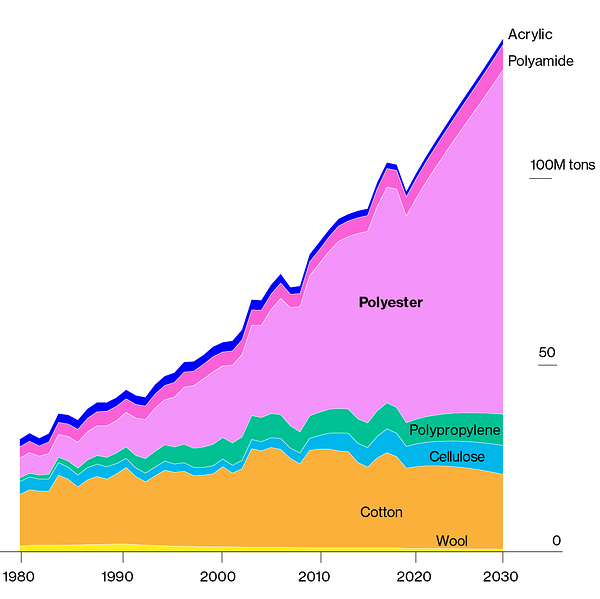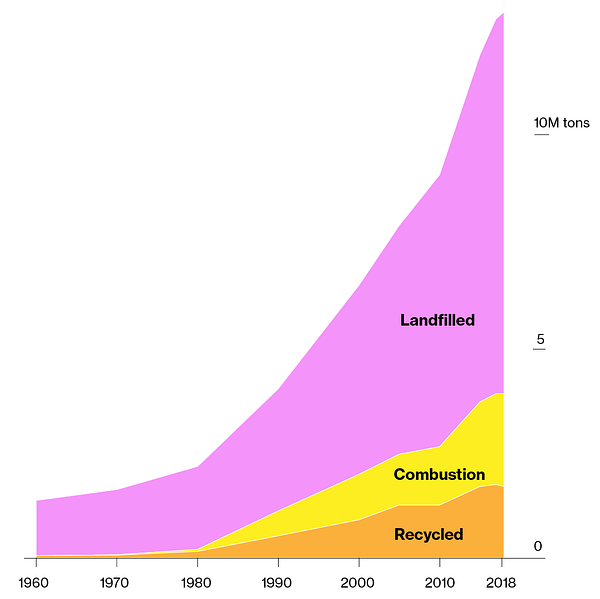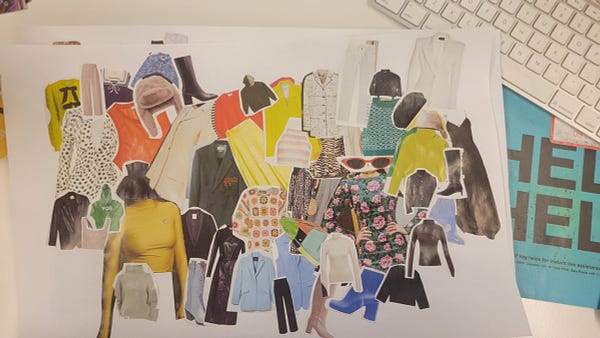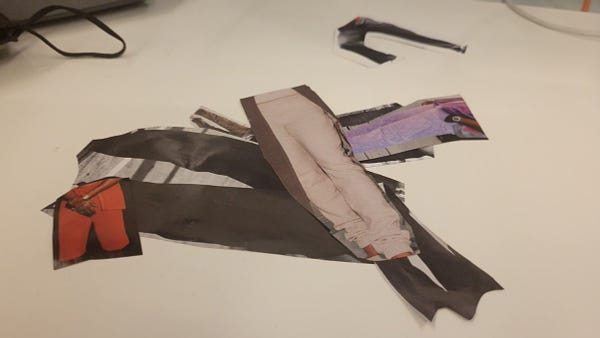By Walt Hickey
Welcome to the Numlock Sunday edition.
This week I spoke to Rachael Dottle, who wrote “The Global Glut of Clothing Is an Environmental Crisis” for Bloomberg. Here's what I wrote about it:
Fashion accounts for 10 percent of global carbon dioxide output, and a fifth of the 300 million tons of plastic produced globally. The global market for polyester yarn in 2022 is currently $106 billion, but is projected to rise to $174.7 billion, and annual polyester production — which turns petroleum into clothes — is projected to increase 47 percent over the next 10 years to 92 million tons. The issue in particular is what comes at the end of the road for apparel: 87 percent of total fiber input for clothing is eventually incinerated or sent to a landfill. For Shein, the online retailer of fast fashion, 95.2 percent of their clothing contains new plastics, from polyester, nylon, acrylic or elastane. In 2015, polyester production was responsible for 282 billion tons of carbon dioxide, triple the carbon impact of cotton.
I really loved this story. It’s incredibly visual, so I highly recommend clicking through and checking it out; Rachael does amazing work with graphics and it’s such a fascinating read.
Rachael can be found at Bloomberg and on Twitter.
This interview has been condensed and edited.
You wrote a really fascinating story looking into the impact of plastics on fashion. You find that they are, really, all over the place. What drew you first to this question?
It actually wasn't the initial question that I went into when I was exploring fashion stories. I started thinking about it because I was trying to find some data on social media and trends in fashion, and whether there was some relationship between them, but the data there is literally nonexistent. There's no data that I was finding. In my research, I started to notice that there was a lot of conversation around the materials, and it blew my mind to find out that so many clothes were made out of plastic.
It was just something I had no concept of. I had never made that connection. I'm not actually alone; surveys show that people, especially millennials and Gen Z, they don't want to use single-use plastics. They want to minimize their use of plastics. But they don't make the connection that actually your clothing has plastic in it, or is made out of plastic.
I always have had the idea of artificial fibers and stuff like that. But no, they're just turning crude oil into nylon or crude oil into polyester. What are some of the ways that oil gets into clothes?
I watched a bunch of those How It's Made 10-year-old videos when I was researching, because I was like, how is it made? I ended up obviously talking to experts, and doing a little bit more than just watching YouTube videos, but it was fascinating to find out basically the same petrochemical products and pellets — I mean, obviously I'm simplifying it — but the same ways that bottles are made is the same way that you can get yarn spun out of that plastic material. It's a petrochemical product. And they can turn it into all different types of textures and thicknesses for yarn. It's essentially plastic.
When you start talking about the recycling process, not that it happens very often, but when those clothes can be recycled? They basically get melted down using chemicals into the same plastic pellets again. It's crazy that you might have a sweatshirt on that feels really soft, but in the end it's straight up plastic.
It was really wild to see just how pervasive a lot of it is because I didn't realize that it was as much of clothing as it is. I naively assumed like, "Oh yeah, clothes, they're mostly cotton." But you looked at Shein, which is an online retailer for fast fashion, and you found that 95.2 percent of their clothes were from new plastics. What's going on there?
In our work, we wanted to get actual, larger-scale data. You have overviews from analysts, and they'll show you the production of polyester, we used that data as well. But in the story I wanted to really see, down to whether we could see what types of clothes were being made out of polyester. We ended up getting data on Shein's daily clothing; we scraped all those websites for brands, they tell you what material the clothing is made out of. That was a way that we could collect that data in a larger sample size.


We grabbed all those daily URLs that are being output, and we just grabbed all the materials listed, and then we could see the fact that most of them — like you said, 95.2 percent — are made with plastic. It's not just plastic, but it's new — not recycled — plastic. We know that, because they do differentiate. We were able to see that in the data. Which is wild, because that's straight up petroleum.
The fashion industry seems particularly obscure. Whenever a company gets in trouble for either labor practices or materials or sourcing or stuff like that, it always comes down to like, "Oh, it's the supplier." It just seems a lot of the industry is actually built on not obviously stating where the clothes are coming from.
I think that's exactly right. I think that where polyester comes from is very much separated by the industry so that you don't really think about it. I think that's intentional; you don't really want to think about where that material is coming from. One of the reasons it's so prevalent is because it's so useful. It makes all your athleisure clothes. It's the cheapest, easiest way to make those different types of fabrics. That's one of the reasons why it's so popular.
You're really good at charts, you have a really good chart in here about just the explosive growth of polyester. The first time I read it, I was like, as a person who thinks that carbon should be sequestered in ways that aren't atmospheric, this isn't terrible; I mean, I would rather have carbon locked into a polo shirt than in the atmosphere, right? But then you wrote about the end life of these products. Do you want to talk about that a little bit?
This story was really a great story to work on because I had so many misconceptions of my own about the industry. And you'd think like, okay, that's fine. I mean, everybody's like, "Sure, I'm buying a bunch of clothes and they're all polyester. But like I wear them for a while, so I'm using them." But it's crazy how even if you do keep them for a while, they're eventually going to end up most likely in a landfill. Most of your clothes are not being recycled. They're ending up in a landfill. Even if you donate them, they're probably still going to end up in a landfill, or they might be burned.
If you think about it, they're using all of these new, straight from the ground fossil fuels and it's being turned into clothing. And that clothing might be worn one, 10, however many times you wear it. But then once you throw it away, that's it. It's going to be sitting in a landfill for hundreds of years. And that's pretty shocking.
Yeah. The alternative, you write about microplastics too, that seems like it's a particularly acute part of this.
Yeah, even worse. While you're wearing them, every time you wash them, tiny fibers are just going into waterways every time you wash in the laundry. They're shedding these tiny microplastics that research has shown pose a danger to wildlife, they pose a danger possibly to humans as well, so terrible all around.
A lot of climate change discourse can sometimes make you, a human being who needs to stay alive on this earth, feel bad about having to wear clothes. But you have this really amazing chart in here all about H&M's unsold inventory and just how much is waste. Obviously the demand is consumer-driven, but the waste is coming from decisions made at the corporate level.
That is one thing that I think was important. When we talked to researchers, when we were looking at the data, I think it was important to convey that a lot of the times as consumers, you feel like the responsibility is thrown onto you by a lot of the climate change discourse, and all about the sustainability discourse in clothing. If you look at a lot of the sustainability reports on fashion websites and brand websites, which I've looked at a million of them, a lot of them are like, "You can do your part by whatever." We wanted to focus a little bit more on the fact that the industry as a whole is making this happen, and it's a bit systemic. Even when it comes to consumers trying to be more responsible by buying, let's say, a recycled polyester shirt, it's not necessarily your fault that that's not saving the world.


You profile at the end a company that is potentially working on making recycling things a little bit easier.
It was interesting to learn that people are working on this issue. The past couple years, the industry has received a lot of criticism. People are looking and they're aware of the fact that there are so many clothes, most of them are not being recycled. They're being sent to countries like Chile, where you just see massive landfills.
It was interesting to talk to a couple startups, a couple companies who are looking at new technologies to recycle actual textiles. One of the issues is, lots of brands say that they want to use recycled polyester, but most of that is coming from recycled bottles right now. That's not changing anything about the fashion industry. Recycled bottles could be turned into more recycled bottles, but instead that's just pulling away from one industry and making clothing that is made out of recycled bottles, but then still going to end up in a landfill.
It's still very linear, right? These companies, like Ambercycle or Circ, they're looking at actually taking that textile waste and turning it back into something else. That could be clothes, it could be something else like rags, I don't know. Basically the problem is that it requires chemicals to separate the clothing, and it requires a bit of a process and infrastructure that doesn't exist right now, especially in the U.S.
It's still in its infancy as a system, but I think that there is some room for innovation. In a super capitalist way of thinking about it, it's a resource that could be used: There's a huge amount of clothing and it's possible to reuse it and make money off of it.
That's a fun takeaway. I'll take it. I know that this was published under Bloomberg Green, which is one of my favorite things that you guys do on this. But you're on the graphics desk over there. Where can folks find you? Where can folks find your work? What can we look forward to?
I do it all as a graphics person, you know what I mean? Graphics here, graphics there. I'm on the Bloomberg Graphics team, I work with CityLab a lot. I work Green, I think we have a lot of interesting stuff coming out. I just love making graphics and I love making weird graphics that catch the eye, but also maybe inform you. I don't have anything crazy coming up because this was a huge project and took a lot of time.



I do have one thing that I really loved about making this story. We bought — we spent $200 of Bloomberg-approved money, and we bought a bunch of magazines at Iconic Magazines in Soho. We cut out all of this clothing, they were all hand-cut and collaged. Jackie and I had a really good time doing that. And so it was my first time trying to make it a little bit more handmade. I mean, obviously we ended up doing a little bit of Photoshop, but it was really fun to cut out and collage.
It was fun. For a very serious topic, but fun.
If you have anything you’d like to see in this Sunday special, shoot me an email. Comment below! Thanks for reading, and thanks so much for supporting Numlock.


